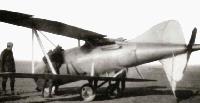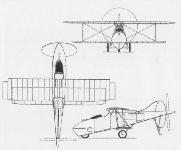
Описание
Страна: Франция
Год: 1917
Fighter
J.Davilla, A.Soltan French Aircraft of the First World War (Flying Machines)
De Bruyere Canard
In April 1917 a canard aircraft ol quite unusual configuration was tested at the Belgian training field at Etampes. This field had previously been used by the Farman and Bleriot firms to test their aircraft; during the war it was used as a test center at which various experimental aircraft were flown.
The canard was built by French engineer De Bruyere. It had a sleek fuselage with the pilot seated ahead of the wings and a Hispano-Suiza engine (type unknown but possibly a 150-hp Hispano-Suiza 8Aa) was mounted inside the fuselage. The two-bladed propeller was at the extreme end of the tail and was driven by a long shaft from the engine. Canards were mounted in the extreme nose of the aircraft. The aircraft was a sesquiplane with the upper wing extended above the fuselage on struts while the lower wing was suspended below the fuselage. There were prominent fins both above and below the rear fuselage. Twin main wheels were suspended below the lower wing and a large nose wheel was semi-recessed in the extreme nose. J.M. Bruce reports that it may have been armed with a 37-mm Hotchkiss cannon.
On its first test flight the aircraft lifted a few meters and then rolled over and crashed. Apparently, it was not rebuilt and further development was abandoned.
Описание:
- J.Davilla, A.Soltan French Aircraft of the First World War (Flying Machines)
- W.Green, G.Swanborough The Complete Book of Fighters
Фотографии
-
J.Herris - Weird Wings of WWI /Centennial Perspective/ (70)
The De Bruyere Canard fighter had a fixed 37mm cannon and an unsynchronized machine gun. The pilot's cockpit was forward of the wings and a Hispano-Suiza V-8 of unknown type was fitted behind the wing in a pusher configuration. The ailerons were rotating wingtips. The aircraft crashed on its first test flight in April 1917; immediately after take-off it rolled inverted and crashed fatally. Over-balancing of the wingtip ailerons may have been the cause. Unfortunately, this innovative design was abandoned instead of being redesigned with conventional ailerons. Introduction of too many innovations in a new prototype offers the hope of breakthrough performance but with a much higher risk of failure.
-
W.Green, G.Swanborough - The Complete Book of Fighters
The bizarre de Bruyere completed in 1917, and which crashed on its first flight attempt.





